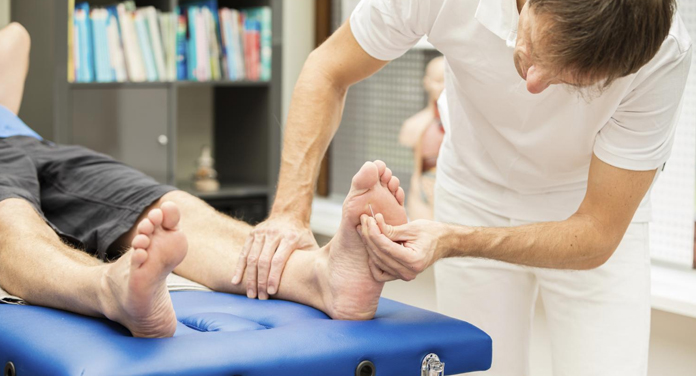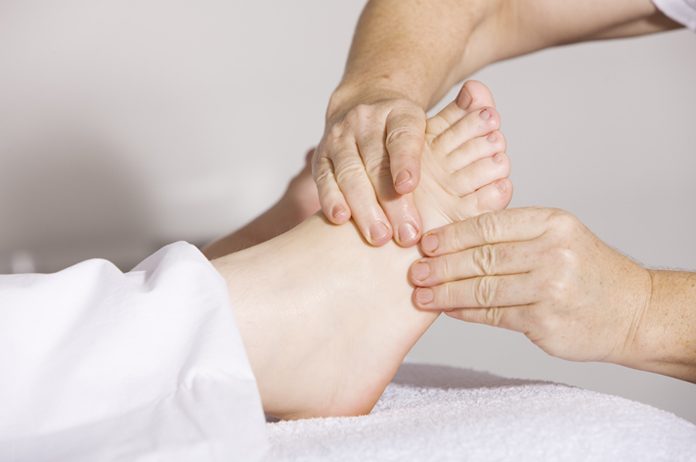If it weren’t for our feet, the simple task of walking, running or even standing would have proven to be impossible.
The tasks we accomplish with our feet are such simple that we do not think much about them until we experience pain.
A sting on the foot or, more specifically, pain on the top of the foot is something more or less every one of us has experienced. The pain, in most cases, is due to overworking your feet.
However, there are situations where the cause is more than just overdoing. Our feet are made up not only of bones and muscles but also ligaments and tendons. Even though the ligaments and tendons are protected with layers of fatty connective tissue, they can get injured.
The force of the pain is influenced by the cause and degree of any possible damage. We might think that the pain is due to overworking and will heal with proper rest, but it might actually be a lot more severe than that. So if you experience any pain on the top of your foot, ask yourself, ‘Why does the top of my foot hurt?’
Causes of Pain on Top of Foot
There might be some significant cause responsible for the pain in our feet. The most common reasons for pain on top of the foot are mentioned below, along with their symptoms and what we can do to treat them.
1. Extensor Tendonitis
This is a kind of inflammation and irritation in the tendons in our foot that results in swelling on top of the foot. This happens when you wear very tight shoes, drop something heavy on your foot and tightness in calf muscles.
Some other causes of this are walking or standing for long periods of time, running or even walking on uneven surfaces or altered foot biomechanics.
Symptoms of Extensor Tendonitis are bruising and swelling on top of the foot, your foot becoming extremely sensitive to touch, and difficulty wearing shoes.
2. Stress Fractures
Overworking your feet can break one of the foot bones, which is often the metatarsal bones.
Jumping, kicking, and running around, especially if tight muscles or sudden activity increases, leads to stress fractures. The symptoms include swelling on the top of the foot and intense pain.
3. Gout Foot
Gout foot occurs due to raised levels of uric acid. It is one kind of inflammatory arthritis and causes crystals in the leg, mostly around the big toe.
Medical conditions like diabetes, purine-rich diets, obesity, and genetics are some of the causes of gout foot. These symptoms include intense pain on the top of our foot, swelling, tenderness that commonly occurs at night, redness, and heat. With proper treatment, the symptoms are expected to settle within a few days.
See Also: Natural Remedies For Gout
4. Nerve Problems
This is when the nerves of our foot get squashed or pinched in the lower back, in the foot or further up the leg. An injury to the foot and wearing tight footwear are the two things that may result in this.
It causes swelling on top of the foot along with pain. Other symptoms are numbness in the feet and the feeling of pins piercing the foot.
Diagnosis
If the pain is due to general stress, it should be cured within a week after a good deal of rest.
However, if it doesn’t, you should immediately get a doctor’s appointment. If the top of your foot hurts with pain so strong that you cannot even walk, or you feel numbness or tingling or a burning feeling on your foot, you should call your doctor.
The doctor can then suggest you consult a podiatrist or orthopaedic who will take care of your foot.
The doctor, be it the general practitioner or a podiatrist, will ask if you injured your foot and about other symptoms that accompanied the pain of your foot.
They will also inquire about any physical activity that might have provided the extra strain to your foot.
They would need to put a little pressure on different foot parts to examine it. You will require walking around a bit and doing a few simple exercises like foot rolling.
The doctor will ask you to arch your foot downwards and pull your toes. If this causes pain, then the reason behind the pain is extensor tendonitis.
They will ask you to undergo an X-ray if they assume the foot has a fracture, a broken bone or a bone spur. Some other tests involve blood tests that help determine if the reason is gout or an MRI to know if the cause is any damage to the peroneal nerve.

Treatment
Some other methods that help a lot in treating this kind of pain are –
1.Physical Therapy
Physical therapy is one of the most sought-after solutions when someone has intense muscle pain. It helps us in learning proper exercises that help us to get rid of the pain faster. It helps in curing conditions such as extensor tendonitis, peripheral neuropathy and damage to the nerve.
2. Rest
Taking enough rest is a necessity if you want the pain to heal as quickly as possible. This makes sure that there is no extra strain on your feet, and it gets the time and relaxation to heal.
3. Elevation
Keeping the sore or hurt area above the level of your heart helps in reducing the swelling. You can use pillows for this and place your legs over them to keep them at an elevated level.
4. Compression
Compression is the method of wrapping an elastic bandage over the sore and swelled area. It prevents the affected area from swelling further.
Never wrap it too tightly since it might cause more swelling below the hurt area. Tingling or numbness while you have the bandage on means that it is wound too tightly.
5. Ice
Placing ice over the swelling helps to reduce it. However, you should never apply ice directly; always use a towel to wrap the ice. You can apply the ice for fifteen or twenty minutes three times a day to get proper results.
6. Plasters
For broken bones or fractures, a cast or a walking boot can do wonders. These help in a way where you wouldn’t have to put enough weight on your leg. This will result in less strain on the bones and muscles and thus help your leg heal faster.
7. Prescribed Drugs
Taking medicines is also another solution. There are anti-inflammatory drugs that help us to reduce the swelling and thus lower the intense pain. Medication helps well in taking care of gout foot.
Conclusion
The pain on the top of our foot due to the causes mentioned above is easily curable. But it would help if you got them treated before they take a turn for the worse even if the pain is just a mild one, rest and not pressure it to worsen the condition. You should consult a doctor if the pain doesn’t subside in a few days.






